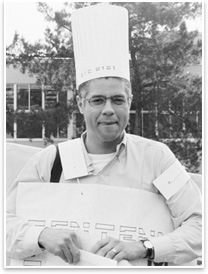
| Thomas Fowler IV, AIA
Education Interest in architecture After college From there, I wanted to go directly into practice, but was convinced to go to graduate school by Bill McMinn, who was the dean at Cornell. I also worked in the college as an administrator—I was director of minority educational affairs. It seemed very bizarre at the time that he wanted me to do that, but it actually provided me an opportunity. When I got to Cornell, I first worked for a year as an administrator and then applied to the graduate program. Fortunately, I was accepted, which allowed me to do graduate work basically for free while working as an administrator. Instead of two years, I took almost four years to complete the two-year post-professional program, but it was the nature of doing it part time. Practice After UC Berkeley, I wanted to go back into practice. I got an offer from Davis Brody in New York and was there for about eight months. That’s when I decided that I really wanted to go back into teaching. I applied for a full time lecturer position at Cal Poly and, after the first year, was hired on a full time basis. There was just something about being around these young students and being quite stimulated in the classroom—always having a fresh bunch of students every quarter. There was something very uplifting and rewarding about that, not that practice didn’t have that, but the rewards in practice are not as frequent. They take longer. I felt it took longer to have that same level of accomplishment and reward, and I was just quite stimulated by working with all these bright minds.
In the classroom I tell the students that I have a lot of fun in the studio, and I hope they would too. If they can have fun, then everything else is easier. I say: “It’s going to be a very difficult time if you’re not enjoying the class, because I’m having fun. So let’s have fun together.” We only have 10 weeks, too, which to me is great because it simulates the urgency of practice and decision making. Receiving the AIA Education Honor Award I started CIDS in 1997 with a Cal Poly Plan Grant of $106,000. I was very happy and surprised that the university had so much faith in my proposal to give me that much money, but it allowed me to start a computer facility, which has evolved beyond what I thought it was going to be. Initially, it was to do high-end computing and integrate it into the design studio with the undergraduates. But, in 2001, I started doing collaborative, interdisciplinary projects using the digital tools as a way of allowing students to generate high-end models. It provided the means and the method by which to collaborate—since ’97, I’ve completed more than 100 interdisciplinary projects. Mentors Also, my cousin Gary McNeil continues to be a mentor. I don’t think I would’ve gone into architecture if I hadn’t had that serendipitous initial summer internship at his office in New York. Also, Bill McMinn at Cornell, who started Mississippi State’s architecture program and won the Topaz Medallion in 2006. He was the one who provided me the opportunity to come to Cornell as an administrator and a student. I couldn’t have become a teacher without the master’s, so he was in some ways the person who opened that door. Leroy Bean is another one. He convinced me to apply for the UC Berkeley position. I met him when I was the national student president. He was one of the co-chairs for the AIA national convention. The last one is the former dean here at Cal Poly, Paul Neel. He’s the one who convinced me to apply for this full-time position at Cal Poly when I was in New York working at Davis Brody. He said: “Why don’t you give it a try? If you don’t like it, you can always go back.” I liked it, and 14 years later I’m still here. I guess I still like it. Engaging young architects on staff I actually spend time trying to figure out what my students are interested in. I have them fill out weekly e-mail journals where they tell me what they accomplished this week and what they’re going to accomplish next week. I don’t think firms connect with employees the way that academics connect with students. I think it would be good for the partners or associate partners to figure out how to connect with the employees. The project architects and the people on the team probably do connect at better levels because they’re in the trenches with their team, but there definitely seems to be a disconnect between those running the firm and the young people in the firm. In some ways, the young people are the ones bringing the firm up to date on how to integrate the latest technology. I find they’re a really important aspect of the profession. If you ignore them or don’t engage them, I think it’s a missed opportunity. |
||
Copyright 2008 The American Institute of Architects. All rights reserved. Home Page |
||
news headlines
practice
business
design
recent related
› Six Programs Receive Education Honor Awards
› William G. McMinn Awarded 2006 AIA/ACSA Topaz Medallion
› Diversity: The Educators
Photos courtesy of Thomas Fowler IV, AIA.
For more information on Professor Fowler’s CIDS studio, visit Cal Poly’s College of Architecture and Environmental Design at To learn about the AIA Education Honor Awards, visit the web site.

 Summary:
Summary: